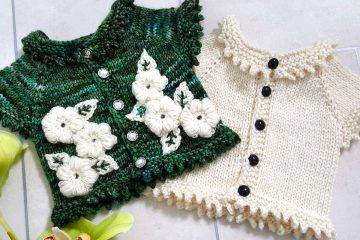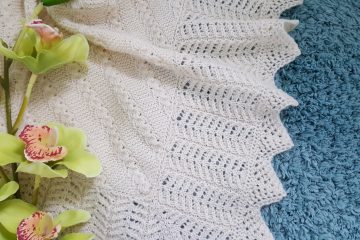 I started spinning some superfine Shetland fibre a few days ago. It is beautiful stuff! Incredibly fine, soft, and surprisingly bouncy. I could see the fine crimp in the fibre as it ran through my fingers and spun up into strands of yarn ready for plying, and it was spinning like a dream. This is only my third spinning project, and I felt like I was spinning gold!
I started spinning some superfine Shetland fibre a few days ago. It is beautiful stuff! Incredibly fine, soft, and surprisingly bouncy. I could see the fine crimp in the fibre as it ran through my fingers and spun up into strands of yarn ready for plying, and it was spinning like a dream. This is only my third spinning project, and I felt like I was spinning gold!
I then started reminiscing about when I began knitting all those years ago, and the things I know now that I wish I knew back then. Out of this I’ve come up with some tips for new knitters that I hope will help you be happier with the craft.
1. The quality of yarn and needles IS important
My Mum is the person who first taught me to knit. I was using leftover old acrylic yarn, and old metal needles. And my first project? Yep, it was a multicoloured scarf that was wider than it was long. The combination of poor quality needles and yarn meant every stitch squeaked and it sent shivers up my spine! Good quality yarn does not necessarily mean pure silk. There are good quality acrylic yarns today, and wool is not as scratchy as you may have been led to believe. And if you aren’t able to invest in quality needles as a beginner knitter, ask a knitterly friend if they would be willing to lend you some to learn.
2. Fun yarn is not always fun
My fun yarn phase is somewhat of a blur to me all these years later. This is possibly a side effect similar to that of post-traumatic stress, where your brain blocks out a painful memory! Fun yarns do have their place in the knitting world. A very small specific place! Think carefully about whether you would wear the finished garment if you really did make it in that fun yarn. I wish I had asked myself this question before I used fun eyelash style yarn to make a strappy summer top!
3. Don’t be afraid of mistakes or to ask for help
We learn through our mistakes. So please don’t be afraid to make them. I also urge you not to be afraid of asking for help. When I was making my first lace project I came across a new to me knitting instruction of “yo” and I could not figure out what it meant. I read and re-read the pattern. I searched online search engines, spending hours trying to figure out what I was meant to be doing (this was before I found Ravelry). Later that evening I gave up and went to ask my Mum. She took the project from my hands, worked the stitch, said that’s it, and I took the project back. Imagine how much further in the pattern I could have been if I had asked for her help 10 hours earlier! In my experience, the knitting community has always been willing to help a fellow struggling knitter.
4. Free patterns are not always your friend
The internet is full of free knitting patterns. Typing “free knitting patterns” into Google and you get over 2.5 million results! There are countless high quality free knitting patterns out there, but there are just as many poorly written free knitting patterns too. I downloaded a huge number of the bad ones when I first started out and it held me back from learning my newly discovered craft. A poorly written knitting pattern for a new knitter can easily discourage you from finishing your project – it can even deter you from knitting altogether! Ravelry is a free online community for knitters and crocheters. They have the largest database of patterns on Ravelry, including free ones. But even better, you can see how many people have made those free patterns and see how their projects came out, giving you a good idea of which are the good ones and which are the baddies!
5. Ravelry
I mentioned the pattern database on Ravelry quickly in the last point. It truly is an amazing site. You can keep track of your projects, including needles, yarn, start and finish dates, notes, and pictures. The pattern database, shown below, has a huge range of search functions, from free to paid, craft type, age, yarn type, designer, garment type, language, and more. You can search for yarns, search for people, join groups and be part of smaller communities, join KALs (knit-alongs), participate in swaps, and generally be part of a worldwide love of yarny crafting. It truly is a work of genius!

6. Swatching can be important
Do you want your jumper to fit your or your doll? Knitting those little 20cm x 20cm squares may seem tedious, and a waste of yarn when you are just starting out. After all, you’ve just spent money on needles and yarn for a craft still new to you. Why would you want to use some of that yarn making a square? Yes, this process is not crucial to some patterns. But for many projects, such as jumpers and cardigans, hats and gloves, socks and legwarmers, this is super important! Alongside being honest with yourself about your size. There is no point knitting a size 6 jumper if you are really a size 12. Taking careful measurements of your little square and of yourself (or intended gift recipient) and noting these right there on your pattern is key to choosing the correct size making something that will fit you. Besides, you can always make a blanket with all your squares and you don’t have to be honest with anyone else about your size!
So these are the things I would go back and tell myself as I ventured into the world of knitting. Let’s show new knitters that the knitting community are super keen on passing on their skills and knowledge and tell me what you wish you had known when you first started knitting in the comments box!
Happy Crafting!



0 Comments